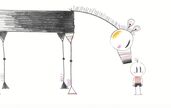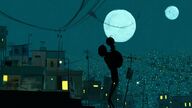The bizarre color splicing, the dazzling rotation and collision, the warm and fast drum beat... all of this is like a criss-crossed childhood dream. "The Boy and the World" depicts a boy and the world in his eyes with a minimalist and extremely gorgeous style, a vast world entangled with dreams.
"No matter where you go, you should remember that the past is false, memory is an endless road, all past springs no longer exist, and even the most tenacious and frantic love is only a kind of A fleeting reality." The film has the same magical realism as "One Hundred Years of Solitude." Crazy flowers and plants, sudden and violent storms, all extremely unrealistic elements are connected with the real world, the real and the fake, the false and the real. Only the eyes of a child can achieve such a vision of coexistence of magic and reality. Due to his lack of experience and his rich subjective imagination, he couldn't tell whether he was just a colorful stone or an all-encompassing kaleidoscope. This resulted in a series of real and imaginary experiences when looking for a father who went out to work.
The combination of shocking reality and fantasy derived from myths and legends enables readers to obtain a feeling of deja vu and unfamiliarity in the image of "paradoxical, paradoxical", thus arousing the pursuit of the writer's true meaning of creation. desire. Magic realism must be based on reality, but this does not prevent it from taking extreme exaggeration. "One Hundred Years of Solitude" is like this, and so is this film. The former shows the century-old historical picture of Latin America, while the latter shows the original appearance of developing Brazil. With economic development, going out to work, and leaving home, thin and dark figures come and go, and the lights come on and off and on again. This is a dream, but also a reality.
View more about The Boy and the World reviews







